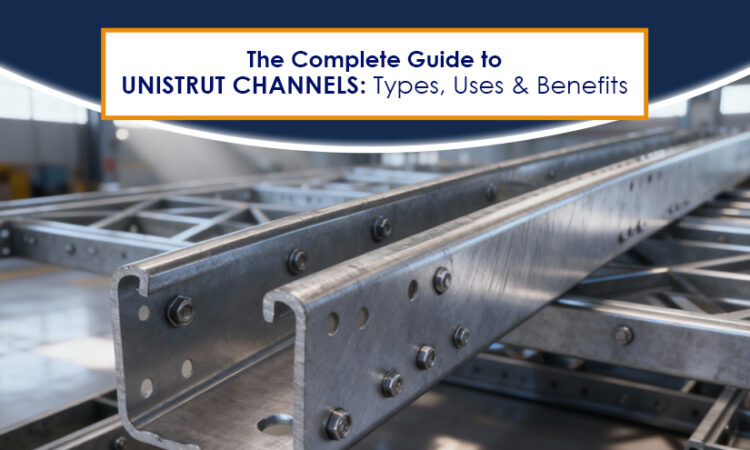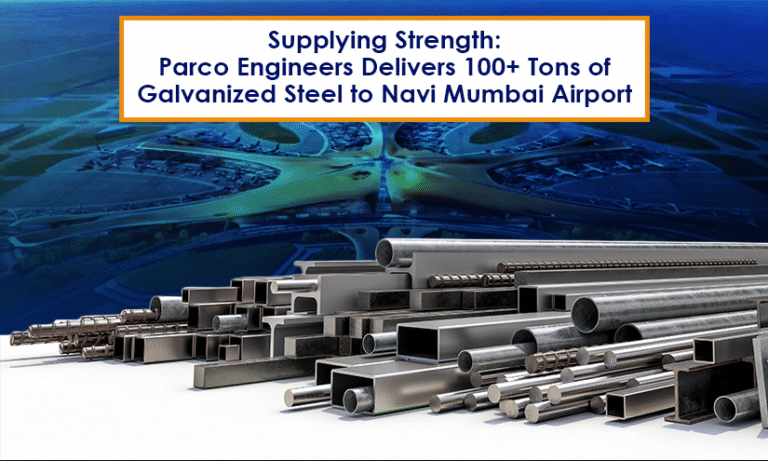The Complete Guide to Unistrut Channels: Types, Uses & Benefits
A Unistrut channel, which is also commonly referred to as a strut channel, is an engineered metal framing system that is used to support, mount, and connect plumbing, mechanical, and electrical equipment. It’s a modular, universal solution that doesn’t require drilling or welding for installation.
Engineered for strength, versatility, and recyclability, Unistrut forms the backbone of steel framing systems in India and globally. For use in industrial piping, cable tray applications, and solar panel frames, Unistrut presents a durable means of constructing frameworks that stand the test of time.
What is Unistrut Used for?
The Unistrut installation system meets a broad spectrum of structural and industrial applications. It’s commonly used for:
- Supporting HVAC ducts, piping, and electrical conduit
- Fabricating cable tray support structures
- Constructing solar Unistrut mounting structures
- Assembling industrial support channels for machinery or equipment
- Designing modular framing systems for warehouses, factories, and commercial buildings
Due to its reusability and flexibility, Unistrut is well-suited for both temporary and permanent installation, saving time and money project wide.
A Unistrut channel is normally a U-channel made of steel with inward-turned lips. The lips contain Unistrut nuts and bolts, brackets, and fittings to join various components together.
It comes in various finishes, such as hot dip galvanized Unistrut for maximum corrosion protection, and supports heavy-duty loads while keeping structural integrity intact.
Types of Unistrut Channels: Which One Suits Your Project?
Knowing the types of strut channels is important in choosing the appropriate system:
Plain Unistrut Channels: Have a solid base, and they give the highest strength and rigidity.
Slotted Unistrut Channels: Comprise pre-punched holes for quick alignment and quicker assembly.
In slotted vs plain Unistrut, the decision hinges on project requirements adjustable or temporary configurations are best with slotted channels, while plain channels deliver highest structural load capacity.
Common Sizes and Material Grades
Unistrut channel sizes and Unistrut channel dimensions differ based on application needs. Typical sizes are 41×21 mm, 41×41 mm, each having a load-bearing capacity for applications.
In choosing materials, Unistrut material grades such as mild steel, stainless steel, and hot dip galvanized Unistrut provide durability in all environments, from factory interiors to exterior solar installations.
Uses & Industry Applications of Unistrut Channels
The versatility of applications of Unistrut in construction and industrial environments makes it a popular selection across industries:
- Construction & Infrastructure: Cable trays, pipe supports, and false ceiling grids
- Renewable Energy: Solar Unistrut mounting systems for panels and frames
- Manufacturing Plants: Unistrut support systems for conveyors, ducts, and cable management
- Data Centers: Modular framing for equipment racks
- Commercial Applications: HVAC and lighting support systems
From light-gauge frameworks to heavy support structures, Unistrut channel spans applications across industries requiring strength, flexibility, and pace.
Top Advantages of Utilizing Unistrut Channels
There are numerous advantages of Unistrut channels that make them invaluable in contemporary engineering and construction:
- No Welding Necessary: Saves installation time and expense
- Reusability: Parts can be disassembled and reinstalled with ease
- Corrosion Resistance: Particularly with galvanized Unistrut channels
- Versatility: Accommodates a variety of configurations with Unistrut fittings and accessories
- Precision: Factory-specified Unistrut channel dimensions provide consistency and quality
Together, these benefits place Unistrut as an industry favorite for those looking for efficient, modular, and cost-effective framing solutions.
Installation Tips and Best Practices
If you’re wondering how to install a Unistrut channel, here are some practical tips:
- Choose the correct Unistrut channel dimensions for your load requirements.
- Always use compatible Unistrut nuts, bolts, and brackets.
- For outdoor or corrosive environments, opt for hot dip galvanized Unistrut channels.
- Follow industrial installation standards to ensure safety and alignment.
- Keep modular flexibility in mind, design for future expansion.
Proper installation guarantees long life and load performance throughout systems.
Unistrut vs Traditional Support Systems
Unistrut versus welded frame comparison and Unistrut stands in a class of its own with the following advantages:
- Faster Installation: No welding or drilling
- Reusability: Easy to modify or expand
- Lower Maintenance: Resistant to corrosion and fatigue
- Precision Fit: Standardized Unistrut channel specifications guarantee accuracy
Unlike traditional welded frames, the modular support approach saves both time and cost, making it the preferred choice in modern infrastructure projects.
How to Choose the Right Unistrut Channel for Your Project
When selecting your system, consider:
- Application Type: Industrial, commercial, or solar
- Load Requirements: Match to correct Unistrut channel size and material
- Environment: Choose between galvanized, stainless steel, or painted finishes
- Fitting Compatibility: Match accessories to your channel profile
- Supplier Reliability: Collaborate with reliable Unistrut producers such as Parco Engineers for quality and tailored solutions.
Unistrut isn’t a product; it’s a total support system designed for flexibility, strength, and innovation. For industrial structures, solar structures, or cable support, Parco Engineers’ hot dip galvanized Unistrut channels are crafted to provide long-lasting performance in all conditions.



